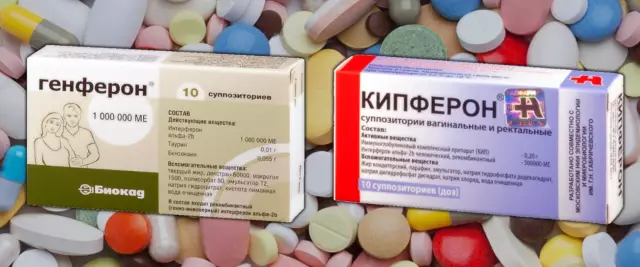- Author Rachel Wainwright [email protected].
- Public 2023-12-15 07:39.
- Last modified 2025-11-02 20:14.
Estrovagin
Estrovagin: instructions for use and reviews
- 1. Release form and composition
- 2. Pharmacological properties
- 3. Indications for use
- 4. Contraindications
- 5. Method of application and dosage
- 6. Side effects
- 7. Overdose
- 8. Special instructions
- 9. Application during pregnancy and lactation
- 10. Use in childhood
- 11. In case of impaired renal function
- 12. For violations of liver function
- 13. Drug interactions
- 14. Analogs
- 15. Terms and conditions of storage
- 16. Terms of dispensing from pharmacies
- 17. Reviews
- 18. Price in pharmacies
Latin name: Estrovagin
ATX code: G03CA04
Active ingredient: estriol (Estriol)
Producer: JSC "Altayvitaminy" (Russia)
Description and photo update: 2020-18-04

Estrovagin is a topical estrogen drug.
Release form and composition
The dosage form of the drug is vaginal suppositories: torpedo-shaped, from white to light cream in color (in a cardboard box, instructions for the use of Estrovagin and 2 blister packs containing 5 suppositories each).
Composition of 1 suppository:
- active substance: estriol - 0.5 mg;
- auxiliary component: Witepsol W35.
Pharmacological properties
Pharmacodynamics
The active substance of Estrovagin - estriol - is an analogue of the natural female hormone. It is used to treat symptoms and conditions caused by a lack of estrogen in women before and after menopause, including surgery.
The drug has a specific colpo- and urotropic activity, therefore it shows high efficiency in urogenital disorders.
It has a selective effect, mainly on the vagina, vulva and cervix. Estriol stimulates blood supply, normalizes the vaginal microflora and the pH of the vaginal environment, helps to restore the epithelium of the vagina and cervix during atrophic changes during premenopause and menopause, affects the quantity and quality of cervical mucus, increases the resistance of the epithelium to inflammatory and infectious processes.
Unlike other estrogens, estriol interacts with sensitive structures for a short time, within 2-4 hours. Due to this, the use of Estrovagin 1 time per day does not contribute to the passage of endometrial proliferation. Therefore, you do not need to use additional progestogens. At the same time, there are no withdrawal bleeding in the postmenopausal period.
Pharmacokinetics
With intravaginal use, the maximum concentration of the drug is achieved within 1-2 hours. In the case of atrophic changes in the vaginal mucosa in the first 3-4 months, there is an increase in the absorption of the drug, as the structure is restored, absorption decreases.
From the body, estriol is excreted mainly in the form of metabolites by the kidneys; about 2% is excreted unchanged through the intestine.
Indications for use
Estrovagin is used in the postmenopausal period for pre- and postoperative therapy in women who are about to or have already undergone vaginal surgery.
For postmenopausal women, the drug is prescribed for hormone replacement therapy for atrophy of the mucous membrane of the lower parts of the urinary tract against the background of estrogen deficiency.
Estrovagin is also used for diagnostic purposes in women with atrophic changes in the epithelium of the cervix with unclear cytological results.
Contraindications
The absolute contraindications to the use of Estrovagin are:
- untreated endometrial hyperplasia;
- bleeding from the vagina of unknown etiology;
- estrogen-dependent malignant neoplasms (including endometrial cancer) or suspicion of their presence;
- established (current or history) or suspected breast cancer;
- active or recent arterial thromboembolism (including myocardial infarction and angina pectoris);
- prior idiopathic thromboembolism or currently present venous thromboembolism (pulmonary embolism, deep vein thrombosis);
- porphyria;
- liver disease (the use of Estrovagin is possible after the normalization of hepatic function);
- period of pregnancy and lactation;
- hypersensitivity to the drug.
Relative contraindications (Estrovagin suppositories should be used with caution):
- leiomyoma;
- endometrial hyperplasia in the history of the disease;
- endometriosis;
- risk factors for the development of estrogen-dependent tumors, for example, the first degree of heredity for breast cancer;
- jaundice (including during a previous pregnancy);
- liver failure;
- benign liver tumors (including adenoma);
- a history of thromboembolism or risk factors for its development;
- arterial hypertension;
- cardiovascular insufficiency;
- bronchial asthma;
- cholelithiasis;
- impaired renal function;
- systemic lupus erythematosus;
- familial hyperlipoproteinemia;
- diabetes mellitus with or without vascular complications;
- otosclerosis;
- severe headache or migraine;
- epilepsy.
Estrovagin, instructions for use: method and dosage
The drug should be used intravaginally. Estrovagin suppositories should be administered before bedtime.
Recommended dosage regimens:
- pre- and postoperative therapy for postmenopausal women: 1 suppository 1 time per day for 2 weeks before or after surgery;
- atrophy of the mucous membrane of the lower parts of the urogenital tract: during the first two weeks - 1 suppository per day, then, depending on the symptoms, the dose is reduced to 2 suppositories 2 times a week;
- diagnostic therapy: 1 suppository every other day for a week before the day of taking a smear.
If the next use is missed, the suppository should be administered as soon as possible, only if this does not mean the use of a double dose. If not, you should skip this dose and follow the usual regimen.
Side effects
With intravaginal administration of Estrovagin suppositories, the following side effects may develop:
- local reactions: irritation and itching at the injection site of the suppository;
- others: soreness and tension of the mammary glands, metrorrhagia, breakthrough bleeding, acyclic spotting.
In the case of the use of Estrovagin simultaneously with gestagens as part of hormone replacement therapy, the following side effects are sometimes noted, the connection of which with estriol has not been proven: estrogen-dependent tumors (including malignant tumors of the endometrium and mammary gland), stroke and myocardial infarction, vascular purpura, erythema nodosum, erythema multiforme, chloasma, gallbladder disease (mainly gallstone disease), venous thromboembolism (including thromboembolism of the pulmonary veins, veins of the small pelvis and lower leg), dementia.
Overdose
Cases of Estrovagin overdose have not been registered. Presumably, an excessively high dose of the drug can cause vaginal bloody discharge, nausea and vomiting.
There is no specific antidote to estriol. Treatment is symptomatic.
special instructions
If long-term treatment is required, it is important to carry out regular medical examinations. Before starting the use of Estrovagin and every 4-6 months during therapy, a general medical and gynecological examination, as well as a study of the mammary glands, is required.
Like all estrogens, estriol is able to retain fluid in the body. Therefore, careful medical supervision is provided to patients with cardiovascular insufficiency and functional disorders of the kidneys.
Influence on the ability to drive vehicles and complex mechanisms
Estrovagin does not adversely affect the reaction rate and cognitive functions of a person.
Application during pregnancy and lactation
During pregnancy and lactation, the use of the drug is contraindicated.
Pediatric use
Estrovagin is not intended for pediatric use.
With impaired renal function
Estrovagin should be used with caution by women with functional impairment of the kidneys.
For violations of liver function
Estrovagin should be used with caution by women with benign liver tumors, liver failure and jaundice, including a history of jaundice of pregnant women.
The use of the drug in liver diseases is contraindicated until the indicators of hepatic function are normalized.
Drug interactions
- powerful inhibitors of microsomal oxidation (ritonavir, nelfinavir): significantly inhibit the metabolism of estriol;
- inducers of microsomal oxidation (rifampicin, phenytoin, rifabutin, carbamazepine, efavirenz, nevirapine, phenobarbital): increase estriol metabolism;
- thyroid hormones and folic acid: enhance the effect of Estrovagin;
- ethanol, general anesthetics, anxiolytics, narcotic analgesics, some antihypertensive agents: reduce the effect of Estrovagin;
- St. John's wort preparations: can increase the metabolism of estriol, as a result of which a decrease in its effectiveness is possible;
- hypoglycemic, diuretic and antihypertensive drugs, antidepressants, anticoagulants and male sex hormones: estriol weakens their effect;
- lipid-lowering drugs: estriol enhances their effect.
Analogs
Ovanelia, Ovestin, Ovipol Klio, Elvagin, Estrokad are analogues of Estrovagin.
Terms and conditions of storage
Store at 2-25 ° C in a dry, dark place. Keep out of the reach of children.
The shelf life is 3 years.
Terms of dispensing from pharmacies
Available without a prescription.
Reviews about Estrovagin
According to reviews, Estrovagin is a worthy alternative to the expensive imported Ovestin (with a price 3 times lower). The drug is highly effective, it well removes such unpleasant symptoms of menopause as burning and dryness in the intimate area, pain during urination caused by estrogen deficiency.
The price of Estrovagin in pharmacies
The price of Estrovagin in the form of intravaginal suppositories is from 374 rubles. per pack of 10

Maria Kulkes Medical journalist About the author
Education: First Moscow State Medical University named after I. M. Sechenov, specialty "General Medicine".
Information about the drug is generalized, provided for informational purposes only and does not replace the official instructions. Self-medication is hazardous to health!






